Louis Armstrong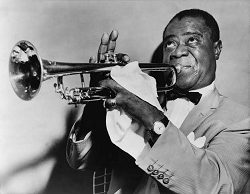
Louis Daniel Armstrong (August 4, 1901 - July 6, 1971) was an American trumpeter and vocalist also known as "Satchmo," "Satch," and "Pops." He is one of jazz's most influential figures. His career has spanned five decades and several eras in jazz history. Armstrong was born in New Orleans and raised there. Armstrong, who rose to prominence in the 1920s as an inventive trumpet and cornet player, was a foundational influence in jazz, shifting the emphasis of the music away from collective improvisation and toward solo performance. Around 1922, he moved to Chicago with his mentor, Joe "King" Oliver, to play in the Creole Jazz Band. In Chicago, he spent time with other well-known jazz musicians, including a reunion with his friend Bix Beiderbecke and visits with Hoagy Carmichael and Lil Hardin. He made a name for himself in "cutting contests," and his fame reached bandleader Fletcher Henderson. Henderson convinced Armstrong to relocate to New York City, where he rose to prominence as a featured and musically influential band soloist and recording artist. Hardin married Armstrong's second wife, and the two returned to Chicago to play together before he started his own "Hot" jazz band. After years of touring, he settled in Queens, and by the 1950s, he had become a national musical icon, thanks in part to his appearances on radio, film, and television, as well as his concerts. Armstrong was an influential singer and skilled improviser, bending the lyrics and melody of a song with his instantly recognizable rich, gravelly voice. He could also do scat singing. Armstrong is well-known for his charismatic stage presence, voice, and trumpet playing. Armstrong's influence had spread to popular music in general by the end of his life. Armstrong was one of the first well-known African-American entertainers to "cross over" to a large following among white (and international) audiences. To the chagrin of fellow African Americans, he rarely publicly politicized his race, but in the Little Rock crisis, he took a well-publicized stand for desegregation. He was able to enter the upper echelons of American society at a time when black men found it difficult to do so. Armstrong appeared in films such as High Society (1956), in which he co-starred with Bing Crosby, Grace Kelly, and Frank Sinatra, and Hello, Dolly! (1969), in which he co-starred with Barbra Streisand. He received numerous honors, including three Grammy Award nominations and a win in 1964 for his vocal performance of Hello, Dolly! He was inducted into the Rhythm & Blues Hall of Fame posthumously in 2017. Early Years Of His Life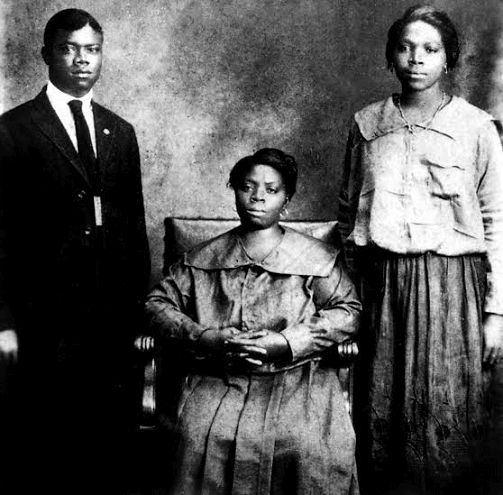
Armstrong was born on August 4, 1901, in New Orleans. His parents were Mary Albert and William Armstrong. Mary Albert was from Boutte, Louisiana, and gave birth at home when she was about sixteen. William Armstrong soon abandoned the family. They had a daughter, Beatrice "Mama Lucy" Armstrong, about two years later, who Albert raised. His grandmother raised Louis Armstrong until the age of five when he was returned to his mother. He grew up in a rough neighborhood known as The Battlefield on Rampart Street's southern end. At the age of six, he enrolled in the Fisk School for Boys, a school that accepted black children in New Orleans' racially segregated system. Armstrong was six years old when he began working for the Karnoffskys, a Lithuanian Jewish family, at their home. He would assist their two sons, Morris and Alex, in gathering "rags and bones" and delivering coal. While recovering from heart and kidney problems at Beth Israel Hospital in New York City in 1969, Armstrong penned "Louis Armstrong + the Jewish Family in New Orleans, LA., the year 1907," a memoir about his time working for the Karnofskys. Armstrong recalls singing "Russian Lullaby" with the Karnofsky family before putting their baby son David to sleep and credits them with teaching him to sing "from the heart." Strangely, Armstrong quotes lyrics for it that appear to be the same as the "Russian Lullaby," which Irving Berlin copyrighted in 1927, about twenty years after Armstrong remembered singing it as a child. Gary Zucker, Armstrong's doctor at Beth Israel Hospital in 1969, shared Berlin's song lyrics with him, and Armstrong quoted them in his memoir. This inaccuracy could simply be due to the fact that he wrote the memoir over 60 years after the events described. Regardless, Armstrong was treated exceptionally well by the Karnoffskys. They fed and nurtured him because they knew he didn't have a father. "I was only seven years old, but I could easily see the ungodly treatment that the white folks were handing the poor Jewish family whom I worked for," Louis Armstrong wrote in his memoir Louis Armstrong + the Jewish Family in New Orleans, La., the Year of 1907. He wrote about what he learned from them, saying that they taught him "how to live-real life and determination." His first musical performance may have occurred alongside the Karnoffskys' junk wagon. He attempted to attract customers by playing a tin horn to distinguish them from other hawkers. Morris Karnoffsky loaned Armstrong money to help him buy a cornet from a pawn shop. Armstrong wore a Star of David until the end of his life as a tribute to the family who raised him. Armstrong dropped out of school at the age of eleven. His mother and he, Lucy, and their common-law husband, Tom Lee, moved into a one-room house on Perdido Street, next door to her brother Ike and his two sons. Armstrong became a member of a quartet of street singers. He was also in hot water. Cornetist Bunk Johnson revealed that he taught the eleven-year-old to play by ear at Dago Tony's honky tonk. He was arrested on December 31, 1912, after illegally borrowing his stepfather's gun and firing a blank into the air. He spent the night in New Orleans Juvenile Court before being sentenced to detention at the Colored Waif's Home the next day. Life at home was simple. There were no mattresses, and most meals consisted of bread and molasses. Captain Joseph Jones used corporal punishment and ran the home like a military camp. By playing in the band, Armstrong honed his cornet skills. Peter Davis, who came to the house frequently at Captain Jones' request, became Armstrong's first teacher and chose him as a bandleader. The thirteen-year-old Armstrong drew Kid Ory's attention with this band. Armstrong was released on June 14, 1914, into the custody of his father and his new stepmother, Gertrude. For several months, he shared a home with two stepbrothers. Armstrong's father never welcomed him after Gertrude gave birth to a daughter, so he returned to his mother, Mary Albert. He had to share a bed with his mother and sister in her small home. His mother still lived in The Battlefield, leaving him vulnerable to old temptations, but he pursued a career as a musician. He got a job at Henry Ponce's dance hall, which had ties to organized crime. He met Black Benny, a six-foot-tall drummer who became his guide and bodyguard. He pimped for a prostitute named Nootsy when he was fifteen, but the relationship ended when she stabbed Armstrong in the shoulder, and his mother choked her nearly to death. He briefly studied shipping management at the local community college before dropping out due to financial constraints. He heard spasm bands, groups that played music out of household objects while selling coal in Storyville. He heard the early sounds of jazz from bands that performed in brothels and dance halls like Pete Lala's, where King Oliver was a regular. CareerRiverboatArmstrong began his career in New Orleans, playing in brass bands and on riverboats, first on an excursion boat in September 1918. He toured with the Fate Marable band on the steamboat Sidney with the Streckfus Steamers line up and down the Mississippi River. Marable was proud of his musical knowledge and insisted that Armstrong and the other musicians in his band learn sight reading. Armstrong described his time with Marable as "going to university" because it provided him with more experience working with written arrangements. In 1919, Armstrong's mentor, King Oliver, decided to move north and resigned from Kid Ory's band; Armstrong took his place. He also became the Tuxedo Brass Band's second trumpet. Armstrong's musicianship matured and expanded during his riverboat experience. He could read music when he was twenty. He was one of the first jazz musicians to be featured on extended trumpet solos, injecting his own personality and style. He also began singing in his performances. Chicago and GennettArmstrong moved to Chicago at King Oliver's invitation in 1922, though he would return to New Orleans on a regular basis for the rest of his life. He could quit his day jobs if he played second cornet to Oliver in Oliver's Creole Jazz Band in the black-only Lincoln Gardens in Chicago's black neighborhood. Despite poor race relations, Chicago was thriving. The city provided jobs for blacks in factories, with some money left over for entertainment. In the early 1920s, Oliver's band was one of the most influential jazz bands in Chicago. Armstrong lived in opulence in his own apartment, which included his first private bath. He began his career-long hobby of writing letters to friends in New Orleans, as excited as he was to be in Chicago. Armstrong could blow 200 high Cs in a row. Other musicians challenged him to cut contests as his reputation grew. On April 5-6, 1923, he made his first studio recordings for Gennett Records with Oliver. They endured several hours on the train to remote Richmond, Indiana, and the band was paid very little. The lack of rehearsal, crude recording equipment, poor acoustics, and a cramped studio all harmed the quality of the performances. These early recordings were true acoustic, with the band playing directly into a large funnel connected directly to the needle making the groove in the master recording. (Electrical recording was not invented until 1926, and Gennett installed it later.) Armstrong's playing was so loud that when he played next to Oliver, Oliver couldn't be heard on the recording. Armstrong had to stand fifteen feet away from Oliver in a far corner of the room. Lil Hardin, whom Armstrong married in 1924, urged Armstrong to seek more prominent billing and develop his style apart from Oliver's influence. Armstrong began to play classical music in church concerts at her suggestion to broaden his skills, and he began to dress more stylishly to compensate for his girth. Her influence eventually strained Armstrong's relationship with his mentor, particularly regarding his salary and additional funds that Oliver withheld from Armstrong and other band members. May Ann Albert, Armstrong's mother, came to visit him in Chicago during the summer of 1923 after being told that he was "out of work, out of money, hungry, and sick"; Hardin found and decorated an apartment for her to live in while she stayed. The Fletcher Henderson OrchestraArmstrong and Oliver reconciled in 1924. Soon after, Armstrong was invited to New York City to perform with the Fletcher Henderson Orchestra, the top African-American band at the time. To blend in better with the other musicians in his section, he switched to the trumpet. Listening to the band's records during this time period will reveal his influence on Henderson's tenor sax soloist, Coleman Hawkins. Armstrong adapted to Henderson's tightly controlled style, playing trumpet and experimenting with the trombone. The Henderson Orchestra performed in prominent venues for white patrons only, including the Roseland Ballroom, with arrangements by Don Redman. Duke Ellington's orchestra traveled to Roseland to see Armstrong's performances. During this period, Armstrong worked with Clarence Williams (a New Orleans friend), the Williams Blue Five, Sidney Bechet, and blues singers Alberta Hunter, Ma Rainey, and Bessie Smith. The Hot Five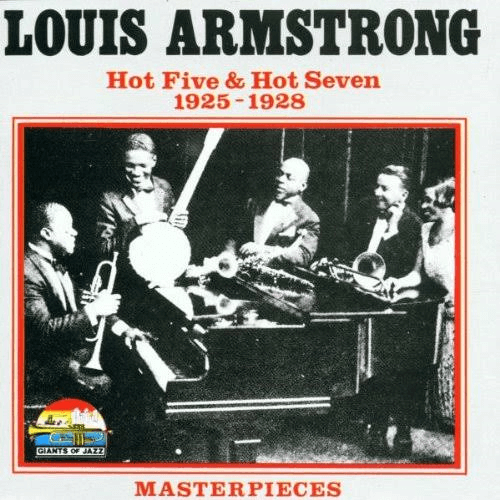
Armstrong returned to Chicago in 1925, largely at the request of Lil, who wanted to expand his career and income. Much to his chagrin, she named him "the World's Greatest Trumpet Player" in publicity. He was a member of the Lil Hardin Armstrong Band and worked for his wife at the same time. He was a member of Louis Armstrong's Hot Five and recorded the hits "Potato Head Blues" and "Muggles." Among the most notable Hot Five and Seven records were "Cornet Chop Suey," "Struttin' With Some Barbecue," "Hotter Than That," and "Potato Head Blues," all of which featured Armstrong's highly creative solos. Armstrong was now free to develop his own style, which included a lot of jives, such as "Whip That Thing, Miss Lil" and "Mr. Johnny Dodds, Aw, Do That Clarinet, Boy!" Armstrong formed his Hot Seven band in the first half of 1927, adding drummer Al "Baby" Dodds and tuba player Pete Briggs while keeping the majority of his original Hot Five lineup. John Thomas replaced Kid Ory's trombone. Later that year, he organized a new round of Hot Five sessions, yielding nine more records. He began recording with a new group in the latter half of 1928, which included Zutty Singleton (drums), Earl Hines (piano), Jimmy Strong (clarinet), Fred Robinson (trombone), and Mancy Carr (banjo). The Harlem RenaissanceArmstrong had a significant impact on the jazz world during the 1920s Harlem Renaissance. His music had an impact on many people, including a well-known writer at the time named Langston Hughes. Hughes admired Armstrong and considered him to be one of the most renowned musicians of the time. Hughes wrote numerous books that upheld the central concept of jazz and recognized Armstrong as one of the most influential figures in the Harlem Renaissance's newfound love of African-American culture. The sound of jazz, as well as the music of other musicians such as Louis Armstrong, influenced Hughes as a writer. Hughes, like the musicians, wrote his words with jazz. Evolving as a vocalistIn 1929, Armstrong returned to New York to play in the pit orchestra for Hot Chocolates, an all-black revue written by Andy Razaf and pianist Fats Waller. He also appeared as a vocalist, frequently stealing the show with his rendition of "Ain't Misbehavin'." His rendition of the song became his best-selling single to date. Armstrong began working at Connie's Inn in Harlem, the Cotton Club's main rival, a venue for elaborately staged floor shows and a front for gangster Dutch Schultz. Armstrong also had a lot of success with vocal recordings, including versions of songs by his old friend Hoagy Carmichael. His 1930s recordings made full use of the new RCA ribbon microphone, introduced in 1931, which imparted a distinctive warmth to vocals and quickly became an integral part of the 'crooning' sound of artists like Bing Crosby. Armstrong's rendition of Carmichael's "Stardust" became one of the most successful versions of the song ever recorded, showcasing Armstrong's distinctive vocal sound and style, as well as his novel approach to singing songs that had already become standard. Armstrong's vocal innovations, like his trumpet playing, laid the groundwork for the art of jazz vocal interpretation. His distinctive gravelly tone became a musical archetype that was widely imitated and endlessly impersonated. His unparalleled experience as a trumpet soloist enriched his scat singing style. His resonant, velvety lower-register tone and bubbling cadences on songs like "Lazy River" influenced younger white singers like Bing Crosby. Health IssuesThe trumpet is a notoriously hard instrument on the lips, and Armstrong suffered from lip damage for much of his life as a result of his aggressive playing style and preference for narrow mouthpieces that stayed in place better but tended to dig into the soft flesh of his inner lip. During a 1930s European tour, he developed a severe ulcer that forced him to stop playing for a year. He eventually began using salves and creams on his lips, as well as shaving off scar tissue with a razor blade. By the 1950s, he had become the official spokesperson for Ansatz-Creme Lip Salve. During a backstage meeting with trombonist Marshall Brown in 1959, Armstrong was advised to see a doctor and receive proper treatment for his lips rather than relying on home remedies, but he did not get around to doing so until his health was failing, and doctors considered surgery too risky. Armstrong was hospitalized for pneumonia while on tour in Italy in 1959. Doctors were concerned about his lungs and heart, but by June 26, he rallied. Personal Life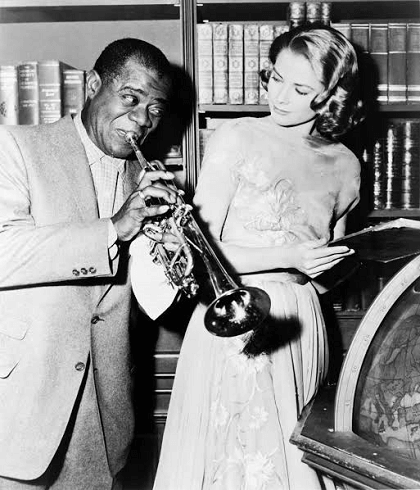
Armstrong met Daisy Parker, a local prostitute while performing at the Brick House in Gretna, Louisiana. He began the affair as a client. He returned to Gretna several times to see her. He mustered the courage to search for her home in order to see her away from work. It was on this occasion that he discovered she had a common-law husband. Parker went to Armstrong's house on Perdido Street not long after this incident. Armstrong and Parker married the next day, March 19, 1919, at City Hall. They adopted Clarence, a three-year-old boy whose mother, Armstrong's cousin Flora, died shortly after giving birth. He married Lil Hardin Armstrong, King Oliver's pianist, on February 4, 1924. Her first husband had died a few years before. His second wife assisted him in furthering his career, but they divorced in 1938 after they separated in 1931. After that, Armstrong married Alpha Smith. His relationship with Alpha began in the 1920s while he was playing at the Vendome and lasted a long time. Their marriage lasted four years before they divorced in 1942. Louis later married Lucille Wilson, a singer at New York's Cotton Club, in October 1942; they were married until his death in 1971. Armstrong's marriages never produced children. However, in December 2012, 57-year-old Sharon Preston-Folta claimed to be his daughter from a 1950s affair between Armstrong and Lucille "Sweets" Preston, a Cotton Club dancer. In a letter to his manager, Joe Glaser, in 1955, Armstrong confirmed his belief that Preston's newborn baby was his daughter and ordered Glaser to pay a monthly allowance of $400 ($5,058 in 2021 dollars) to mother and child. Death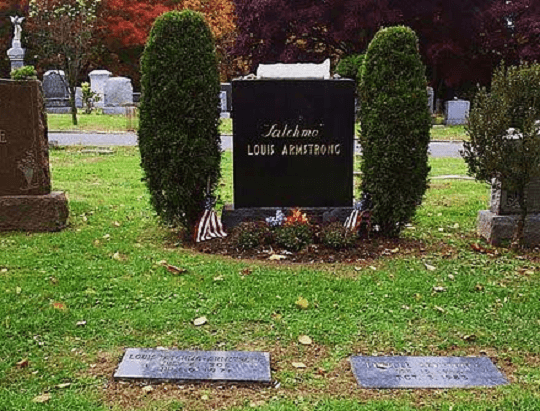
Against his doctor's advice, Armstrong performed at the Waldorf-Empire Astoria's Room for two weeks in March 1971. He was hospitalized at the end of it for a heart attack. He was released from the hospital in May and quickly resumed trumpet practice. Armstrong died in his sleep on July 6, 1971, two days after celebrating his alleged 71st birthday and a month before his actual 70th birthday, still hoping to get back on the road. At the time of his death, he was living in Corona, Queens, New York City. He was laid to rest in Flushing Cemetery in Queens, New York. Bing Crosby, Ella Fitzgerald, Dizzy Gillespie, Pearl Bailey, Count Basie, Harry James, Frank Sinatra, Ed Sullivan, Earl Wilson, Alan King, Johnny Carson, and David Frost served as honorary pallbearers. At the services, Peggy Lee sang the Lord's Prayer, Al Hibbler sang "Nobody Knows the Trouble I've Seen," and Fred Robbins, a long-time friend, delivered the eulogy.
Next TopicMalcolm X
|
 For Videos Join Our Youtube Channel: Join Now
For Videos Join Our Youtube Channel: Join Now
Feedback
- Send your Feedback to [email protected]
Help Others, Please Share









